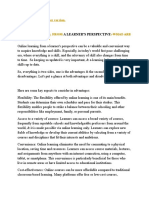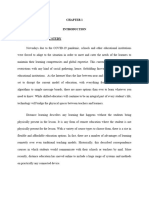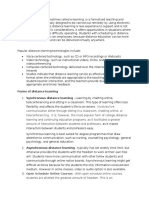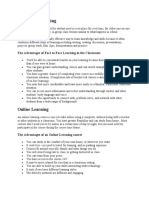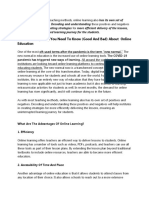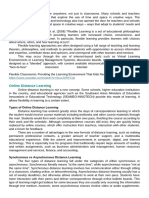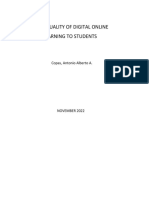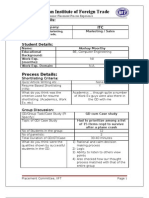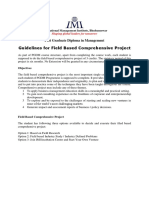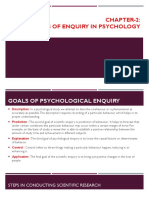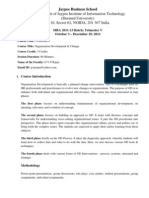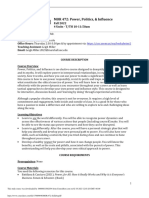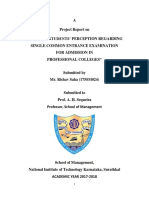Online Learning Vs Classroom Learning
Online Learning Vs Classroom Learning
Uploaded by
Enola HolmesCopyright:
Available Formats
Online Learning Vs Classroom Learning
Online Learning Vs Classroom Learning
Uploaded by
Enola HolmesOriginal Title
Copyright
Available Formats
Share this document
Did you find this document useful?
Is this content inappropriate?
Copyright:
Available Formats
Online Learning Vs Classroom Learning
Online Learning Vs Classroom Learning
Uploaded by
Enola HolmesCopyright:
Available Formats
Online Learning vs Classroom Learning #1: No Human Interaction: The most obvious difference
someone thinks of when comparing the two is the perceived lack of human interaction, however
this isn’t technically true. The correct way to phrase this would be ‘no physical interaction’.
Classroom Learning involves physical interactions with a teacher and peers, while online learning
transfers this component to a virtual environment. So while there is human interaction, it happens
online via virtual lectures, virtual discussions, face-to-face video workshops etc.
Online Learning vs Classroom Learning #2: 24/7 access to learning materials: With online courses,
students can always access learning materials such as module contents, assignments, lecture
materials, podcasts and recorded sessions anytime during the course of their studies. For
postgraduate courses module tutors are always there to assist with any questions through emails,
messages and Skype calls. With Classroom Learning, be it for a school or university courses, a
student has to visit the physical location to speak with tutors face to face, during assigned hours.
This can be limiting, especially for working professionals.
Online Learning vs Classroom Learning #3: Practice while you study: For University courses, Online
Learning students can fit studies around their work schedules, and can immediately practice new
concepts learned by applying them in their current scope of work. With classroom learning
university courses, this is not often the case. Since students have to leave their job and social
commitments to complete a degree programme, they will only be able to practice the new
knowledge once they have re-joined the workforce. When it comes to schools and younger learners,
a lot of Online Learning tools and apps help students understand concepts on a deeper level by
providing problems they can interact and solve with in different ways. For example, logic puzzles or
math puzzles that aren’t the cut and dry ‘solve for x’ prevalent in classroom learning.
Online Learning vs Classroom Learning #4: Assessments: The Classroom Learning method of
assessing a student’s capabilities is usually through quizzes and exams, most often one in a physical
setting invigilated by an examiner. Covid-19 has made this method of assessment (temporarily)
redundant. In Online Learning, assessments are undertaken via assignments, which can be either
individual or group-based, providing an opportunity for students to form study groups that support
each other and learn from their differing experiences. In rarer cases, online, open-book exams are
also used as an assessment medium, however the latter is more popular.
Online Learning vs Classroom Learning #4: Agility: Course materials can be accessed from anywhere
in the world, regardless of differences in time zones, the location of the student, or their current
status. From a busy working professional studying online in the late hours of the evening, to a stay
at home mum brushing up their knowledge before getting back on the job market, online learning
provides the much needed flexibility to study and finish a degree at each one’s own pace.
https://www.staffordglobal.org/articles-and-blogs/general-articles-and-blogs/5-differences-between-online-learning-vs-classroom-learning/
You might also like
- Online Vs Offline LearningDocument8 pagesOnline Vs Offline Learning12-A Rohith YNo ratings yet
- Module No. 4: Flexible Learning EnvironmentDocument14 pagesModule No. 4: Flexible Learning EnvironmentMika Virtudazo100% (2)
- Syllabus (CE 353)Document2 pagesSyllabus (CE 353)abe97No ratings yet
- LSAT Study GuideDocument6 pagesLSAT Study GuideJulia A75% (4)
- انجلزDocument4 pagesانجلزhaadi1212haNo ratings yet
- Anjali DissertationDocument34 pagesAnjali DissertationIsha SharmaNo ratings yet
- Traditional Education and e EducationDocument10 pagesTraditional Education and e EducationSunnyKumarNo ratings yet
- Online ClassesDocument5 pagesOnline Classesk BNo ratings yet
- A Tour of The Student's E-Learning PuddleDocument8 pagesA Tour of The Student's E-Learning PuddleAnonymous IlrQK9HuNo ratings yet
- Handout No. 3 (ED 108 - Finals)Document6 pagesHandout No. 3 (ED 108 - Finals)NISPEROS, LIWAY JOY E.No ratings yet
- Advantages and Disadvantages of Online Learning: Is It The Right Choice For You?Document10 pagesAdvantages and Disadvantages of Online Learning: Is It The Right Choice For You?Imran MaqsoodNo ratings yet
- English Projech Class 11Document25 pagesEnglish Projech Class 11Mitu PatelNo ratings yet
- Assignment No. 2: Name of StudentDocument20 pagesAssignment No. 2: Name of StudentAli DaniyalNo ratings yet
- 13 Differences Between Online and Face To Face CoursesDocument7 pages13 Differences Between Online and Face To Face CoursesIrish MagataoNo ratings yet
- Article On Online Learning From A Learner's Perspective v2Document5 pagesArticle On Online Learning From A Learner's Perspective v2KRISHNA KUMARNo ratings yet
- How Do Online Courses Work in CollegeDocument8 pagesHow Do Online Courses Work in Collegeafiwhyber100% (2)
- Final Summary and Reflection Modules 6-10Document8 pagesFinal Summary and Reflection Modules 6-10api-264575628No ratings yet
- Pros and ConsDocument2 pagesPros and ConsElana GuliyevaNo ratings yet
- Challenges in ODL and How To Overcome ItDocument3 pagesChallenges in ODL and How To Overcome ItNUR AMALIA ADRIANA ALADEN ABDUL RAHMANNo ratings yet
- ACKNOWLEDGEMENTDocument26 pagesACKNOWLEDGEMENTMitu PatelNo ratings yet
- Field Study 1: Lesson 2: The Virtual Learning Environment I. Learning CompassDocument10 pagesField Study 1: Lesson 2: The Virtual Learning Environment I. Learning CompassMarlou ArizalaNo ratings yet
- Learning SkillsDocument5 pagesLearning SkillsCikgu KaviNo ratings yet
- Strengths and Weaknesses of Online LearningDocument6 pagesStrengths and Weaknesses of Online LearningAllan TomasNo ratings yet
- Activity 1 Issues, Trends UnitDocument4 pagesActivity 1 Issues, Trends UnitBernardo MagdaongNo ratings yet
- Classroom Vs Online ClassDocument7 pagesClassroom Vs Online ClassZAIHASRA BINTI AHMAD KPM-GuruNo ratings yet
- Rico, Brechyl F. (Final Paper) 3-2Document17 pagesRico, Brechyl F. (Final Paper) 3-2alexisflrs18No ratings yet
- Mteduc Distance LearningDocument5 pagesMteduc Distance LearningJerica AlondraNo ratings yet
- Online Learning Vs Onsite LearningDocument6 pagesOnline Learning Vs Onsite LearningAR M AbdessadikNo ratings yet
- Pros and Cons of Online Learning-WPS OfficeDocument13 pagesPros and Cons of Online Learning-WPS OfficeJelly Ann VillamarzoNo ratings yet
- Episode 1 - To PrintDocument7 pagesEpisode 1 - To PrintRosary LubongNo ratings yet
- Answer:: What Is The GOAL For Your High-Quality Blended Learning Prototype?Document3 pagesAnswer:: What Is The GOAL For Your High-Quality Blended Learning Prototype?Welfredo Red Wolf YuLptNo ratings yet
- Traditional vs. Online EducationDocument5 pagesTraditional vs. Online EducationEdilbert Bonifacio GayoNo ratings yet
- Topic-Online Classes Vs Offline Teaching:What Is Better?Document10 pagesTopic-Online Classes Vs Offline Teaching:What Is Better?Zahra SalimNo ratings yet
- How Do Online Courses Work ConcordiaDocument4 pagesHow Do Online Courses Work Concordiaujsqjljbf100% (2)
- Activity Guide and Evaluation RubricDocument5 pagesActivity Guide and Evaluation Rubricerika cubidesNo ratings yet
- PatrickDocument14 pagesPatrickSantino AdmanaNo ratings yet
- Face To Face LearningDocument9 pagesFace To Face LearningmebrahtenNo ratings yet
- What Is Online Learning (Question)Document2 pagesWhat Is Online Learning (Question)BM1SJKC-0620 Tina Low Tian SimNo ratings yet
- Traditional Education Vs Online EducationDocument2 pagesTraditional Education Vs Online EducationАнар ҚұдайбергеноваNo ratings yet
- El Profesor Virtual Un Caso de Estudio Personal KearsleyDocument9 pagesEl Profesor Virtual Un Caso de Estudio Personal KearsleyCarlos Romero0% (1)
- Advantages of Online or Computer-Based LearningDocument10 pagesAdvantages of Online or Computer-Based LearningDee VignetteNo ratings yet
- Advantages and Disadvantages of Online LearningDocument6 pagesAdvantages and Disadvantages of Online LearningThùy Cô100% (1)
- Emergence & Significance of Online Education Over Classroom LearningDocument12 pagesEmergence & Significance of Online Education Over Classroom LearningParveenNo ratings yet
- Education Online The Latest State of ResearchDocument54 pagesEducation Online The Latest State of ResearchHalina Ostańkowicz-Bazan100% (1)
- Flexible LearningDocument7 pagesFlexible LearningJames Fomeg-asNo ratings yet
- Distance Learning Education VS Traditional Learning EducationDocument21 pagesDistance Learning Education VS Traditional Learning EducationJoan Adelaide BigleteNo ratings yet
- Independent CourseworkDocument6 pagesIndependent Courseworkg6934kr2100% (1)
- Zain - Eng Assignment 4Document1 pageZain - Eng Assignment 4abubakarzulfiqar120No ratings yet
- Kearl O. Mandao RSDocument24 pagesKearl O. Mandao RSKearl MandaoNo ratings yet
- How Effective Is Online Learning - What The Research Does and Doesn't Tell Us (Opinion)Document4 pagesHow Effective Is Online Learning - What The Research Does and Doesn't Tell Us (Opinion)Ali PapilaNo ratings yet
- Elc093 April 2021 Final Test - Question PaperDocument11 pagesElc093 April 2021 Final Test - Question PaperAinaa KhaleesyaNo ratings yet
- Blended LearningDocument3 pagesBlended LearningitsjewdyeNo ratings yet
- EnglishDocument3 pagesEnglishSaliya RathnayakeNo ratings yet
- What Is Distance LearningDocument5 pagesWhat Is Distance Learningojok felixNo ratings yet
- Hybrid Learning ModalityDocument10 pagesHybrid Learning ModalityMariane Joy TecsonNo ratings yet
- Prof. Ed. 5 LP4 (Sir Irene)Document10 pagesProf. Ed. 5 LP4 (Sir Irene)Antonette Gilboy CabrillasNo ratings yet
- Online Education vs. Traditional Education: The Pros and Cons - SaralStudyDocument14 pagesOnline Education vs. Traditional Education: The Pros and Cons - SaralStudyRavneetNo ratings yet
- Name: Year: Subject: Assessment Ii Date: Instructor/Professor: MR. ROMEO REDULLADocument3 pagesName: Year: Subject: Assessment Ii Date: Instructor/Professor: MR. ROMEO REDULLANormina CagunanNo ratings yet
- Eventuality of Digital OnlineDocument10 pagesEventuality of Digital OnlineDiana May DayaoNo ratings yet
- Research Assignment 2Document7 pagesResearch Assignment 2api-534630138No ratings yet
- Research MethodsDocument12 pagesResearch MethodsNagwa IbrahimNo ratings yet
- Short-Term Financing - Extra CreditDocument7 pagesShort-Term Financing - Extra CreditEnola HolmesNo ratings yet
- Social Media and The Development of Eating DisordersDocument3 pagesSocial Media and The Development of Eating DisordersEnola HolmesNo ratings yet
- Quiz On Transfer PricingDocument7 pagesQuiz On Transfer PricingEnola Holmes100% (1)
- SCM Finals - Extra CreditDocument16 pagesSCM Finals - Extra CreditEnola HolmesNo ratings yet
- Cpa Review School of The Philippines: ManilaDocument18 pagesCpa Review School of The Philippines: ManilaEnola HolmesNo ratings yet
- Financial Statement AnalysisDocument33 pagesFinancial Statement AnalysisEnola HolmesNo ratings yet
- The Globalization Experience in The PhilippinesDocument1 pageThe Globalization Experience in The PhilippinesEnola HolmesNo ratings yet
- Video Games Addiction and Health RisksDocument3 pagesVideo Games Addiction and Health RisksEnola HolmesNo ratings yet
- Definition and Types of Domestic ViolenceDocument1 pageDefinition and Types of Domestic ViolenceEnola HolmesNo ratings yet
- Impact of Covid-19Document2 pagesImpact of Covid-19Enola HolmesNo ratings yet
- A Short Essay About Social Networking Sites and Its Advantages and DisadvantagesDocument4 pagesA Short Essay About Social Networking Sites and Its Advantages and DisadvantagesEnola HolmesNo ratings yet
- Suicidal Thoughts and Behaviors and How To Prevent ItDocument5 pagesSuicidal Thoughts and Behaviors and How To Prevent ItEnola HolmesNo ratings yet
- Handouts Relevant CostingDocument20 pagesHandouts Relevant CostingFuturamaramaNo ratings yet
- NDT Inspector ResumeDocument5 pagesNDT Inspector ResumeulocksystemNo ratings yet
- Common Mistakes Done by UPSC Aspirants and How To Avoid Those MistakesDocument5 pagesCommon Mistakes Done by UPSC Aspirants and How To Avoid Those MistakesChinmay JenaNo ratings yet
- All Cambridge Exams For KidsDocument7 pagesAll Cambridge Exams For KidsVictor Piedade67% (3)
- DISC 212-Introduction To Management Science-Raza Ali Rafique-Mohsin Nasir JuttDocument5 pagesDISC 212-Introduction To Management Science-Raza Ali Rafique-Mohsin Nasir JuttAdeel ShaikhNo ratings yet
- Revised Rate of Remunerations For Exam DutiesDocument12 pagesRevised Rate of Remunerations For Exam DutieskanchankonwarNo ratings yet
- 0455 Economics: MARK SCHEME For The May/June 2007 Question PaperDocument3 pages0455 Economics: MARK SCHEME For The May/June 2007 Question PaperMashhood AhmedNo ratings yet
- Criminological Research & Statistics: Pagadian Capitol CollegeDocument9 pagesCriminological Research & Statistics: Pagadian Capitol CollegeJay-r Pabualan DacoNo ratings yet
- AkshayMoorthy 55 ITCDocument3 pagesAkshayMoorthy 55 ITCAbhishek GuptaNo ratings yet
- Guidelines For Field Based Comprehensive Project: Post Graduate Diploma in ManagementDocument8 pagesGuidelines For Field Based Comprehensive Project: Post Graduate Diploma in ManagementAnkaj AroraNo ratings yet
- UT Dallas Syllabus For Psy4v90.003.07f Taught by John Stilwell (Stilwell)Document3 pagesUT Dallas Syllabus For Psy4v90.003.07f Taught by John Stilwell (Stilwell)UT Dallas Provost's Technology GroupNo ratings yet
- 27160icai UpscDocument2 pages27160icai UpscVarinder AnandNo ratings yet
- VCE-Maths MethodsDocument15 pagesVCE-Maths MethodsforlyneNo ratings yet
- Aakash BYJU - S Booking Pitch For Repeaters - (Attempting JEE - NEET in 2023)Document5 pagesAakash BYJU - S Booking Pitch For Repeaters - (Attempting JEE - NEET in 2023)Rohit YadavNo ratings yet
- Method of PsychologyDocument36 pagesMethod of PsychologyJayshri ThakurNo ratings yet
- Course Outline - OD & ChangeDocument4 pagesCourse Outline - OD & ChangeKuenzang Tshokyee Sangey100% (1)
- B.tech PE Syllabus AR16 RevisedDocument237 pagesB.tech PE Syllabus AR16 RevisedSudhakar PotnuruNo ratings yet
- Ph. D. Entrance Test: Previous Year Question PaperDocument9 pagesPh. D. Entrance Test: Previous Year Question PaperBharath T SNo ratings yet
- MOR 472 Syllabus PDFDocument8 pagesMOR 472 Syllabus PDFVahanNo ratings yet
- ICAR Counseling SRF BrochureDocument70 pagesICAR Counseling SRF BrochureSharat PrabhakaranNo ratings yet
- Learning Environment, Attitudes and Achievement Among Middle-School Science Students Using Inquiry-Based Laboratory ActivitiesDocument21 pagesLearning Environment, Attitudes and Achievement Among Middle-School Science Students Using Inquiry-Based Laboratory ActivitiesMuchsin SimpsonsNo ratings yet
- Teachers Weekly Report To PrincipalDocument3 pagesTeachers Weekly Report To PrincipaldaadapatrickNo ratings yet
- The Use and Abuse of Private TuitionDocument2 pagesThe Use and Abuse of Private TuitionDiana DumitrescuNo ratings yet
- Teaching Resume 1Document3 pagesTeaching Resume 1api-296601280No ratings yet
- 5 Ways To Kill Your DreamsDocument9 pages5 Ways To Kill Your Dreamsacantres18100% (1)
- Study of Students' Perception Regarding Single Common Entrance Examination For Admission in Professional CollegesDocument33 pagesStudy of Students' Perception Regarding Single Common Entrance Examination For Admission in Professional CollegesRishav SahaNo ratings yet
- Republic of The PhilippinesDocument13 pagesRepublic of The PhilippinesGlaiza Joyce Suniega RomanoNo ratings yet
- Impact of Socio-Economic Status On Academic Achievement of University Students Case Study Erbil CityDocument13 pagesImpact of Socio-Economic Status On Academic Achievement of University Students Case Study Erbil CityInternational Journal of Innovative Science and Research Technology100% (1)
- How One Company Identified The Best Candidates For ManagementDocument4 pagesHow One Company Identified The Best Candidates For ManagementLeadership Coaching Rajiv BurmanNo ratings yet














